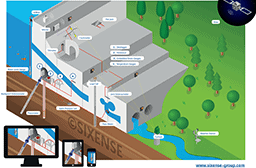Hydrological sensors are used to monitor water quality and water levels in a broad range of situations, including rainwater, surface water, groundwater, rivers and reservoirs.
They are used for many purposes:
- Environmental monitoring of rivers, aquifers, reservoirs and watersheds
- Monitoring of hydraulic infrastructures (dams, water treatment plants, etc.)
- In the context of subsurface contracting beneath the water table, lowering of water tables and wells
- Soil remediation
They are often combined with meteorological and geotechnical sensors.
